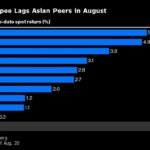What’s going on here?
Major currencies are fluctuating ahead of key policy decisions from central banks, reflecting diverse economic changes and political dynamics.
What does this mean?
The euro firmed slightly in anticipation of the European Central Bank’s (ECB) upcoming policy decision. With a stronger-than-expected recovery in business activity and inflation confidence, economists forecast quarter-point cuts by the ECB in September and December. Meanwhile, the US dollar weakened as markets priced in nearly 50 basis points of rate cuts by the Federal Reserve, anticipating an easing cycle starting in September. This follows data showing growth in the US services sector but ongoing employment concerns. Elsewhere, the Canadian dollar edged higher after the Bank of Canada cut its key rate – the first of the G7 nations to do so.
Why should I care?
For markets: Navigating global economic signals.
Currencies like the euro, US dollar, and Canadian dollar are reflecting divergent policy moves and economic conditions. The euro’s strength is buoyed by the ECB’s cautious approach to lowering borrowing costs, while the US dollar weakens on the back of expected Fed rate cuts. These movements underscore how central bank decisions and economic reports can significantly impact currency values, influencing international trade and investment decisions.
The bigger picture: Interconnected economies and their ripple effects.
Currency fluctuations highlight the interconnected nature of global economies. The yen’s recent rise, influenced by emerging market turbulence and the Bank of Japan’s potential bond purchase reductions, shows how political and financial developments in one region can reverberate globally. Meanwhile, the Mexican peso’s stability amid political concerns and yen-funded carry trade reversals underscores the complex interactions between currencies, market sentiment, and geopolitical events. These shifts remind us of the intricate web of factors influencing global financial stability and economic strategies.




















